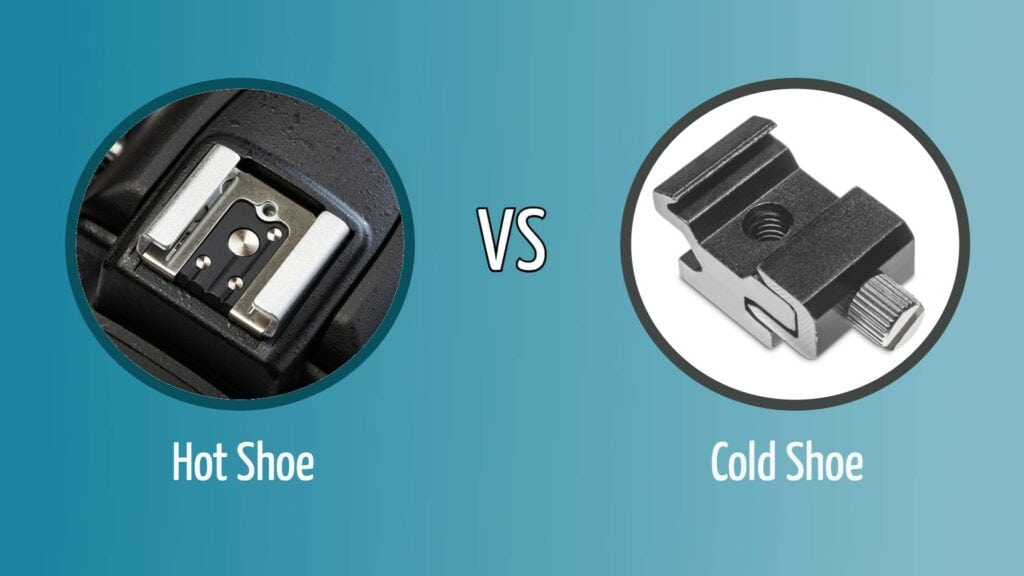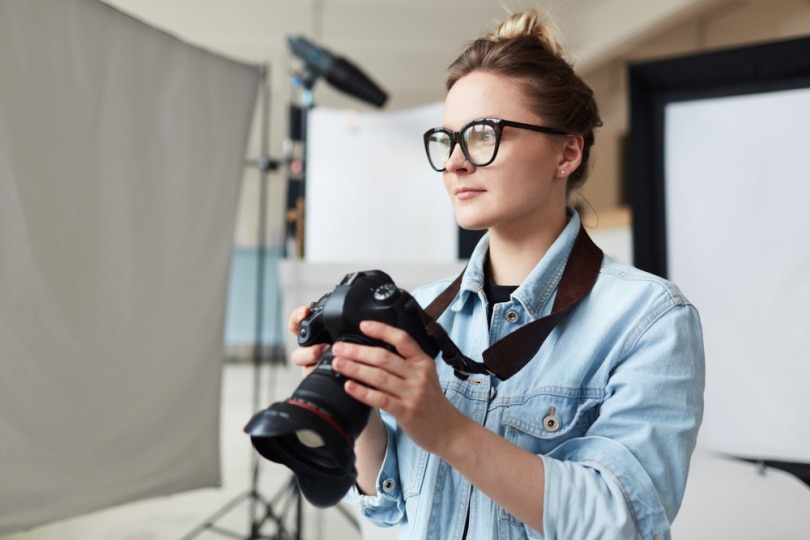Hot Shoe vs. Cold Shoe: What’s the Difference?
Last Updated on

When you’re looking at cameras, one thing that you’ll want to check is whether it has a hot shoe or a cold shoe. But figuring out what each one is and what it does doesn’t always make the most sense.
That’s why we created this guide to clear things up. We break down what each type of shoe is, when you want each one, and if you even need one at all!

Overview of Hot Shoe
The hot shoe sits on top of the camera body and usually has a square design with an angled metal bracket where you can slide different accessories.
A hot shoe uses battery terminals to establish a connection between the attachment and the camera to power it up. Without those terminals, the connector is not a hot shoe.

Different Accessories for a Hot Shoe
While a flash is the most common accessory that people connect to their camera’s hot shoe, it’s far from the only option. Also, keep in mind that most cameras have different flash options that you can connect to a hot shoe.
If you’re trying to figure out the different ways that you can use your camera’s hot shoe, here are a few different types of attachments that you might be able to find:
- Smartphone adapters
- Video-recording screen adapters
- Microphone adapters
- USB docks
If you have an idea of what you want for your camera and it has a hot shoe adapter, there’s a good chance that somebody has what you’re looking for.
What Cameras Come With a Hot Shoe?
The good news is that most mid-range and high-end DSLR and mirrorless cameras come with a hot shoe.
However, if you only have a compact camera or if you go for a lower-end DSLR, there’s a good chance that it doesn’t have a hot shoe.

Are All Camera Hot Shoes the Same?
While all camera hot shoes work off the same basic principles, the actual battery connections on each hot shoe are different.
Therefore, the hot shoe on your Nikon camera might be different than the one on your Sony camera. Even if the attachment fits into place, it might not work if the terminals don’t line up. If they run off different voltages, you might damage the attachment, the camera, or both.
- Offers tons of versatility
- You can create unique camera setups
- Only available on expensive cameras
- Each manufacturer has its own connectors

Overview of Cold Shoe
A cold shoe is similar to a hot shoe, with the primary difference being that a cold shoe does not have any power terminals.
It’s often a metal bracket on top of the camera body that you can attach various accessories to. That said, you can also find cold shoes on top of tripods and other camera accessories that don’t connect directly to the camera. These devices don’t have their own power supply, so it makes sense that they only have a cold shoe. While a cold shoe doesn’t provide power to the accessory, you can power it up with a cable connected to a power source.

Different Camera Accessories for a Cold Shoe
While a cold shoe might not seem all that useful, especially compared to a hot shoe, that’s likely because you’re only thinking of the mobile applications. That’s not really where a cold shoe shines. Instead, think about studio applications. A hot shoe can only use the power from the camera, and that limits the maximum power output to the accessory.
With a cold shoe, you can use an external power source, which allows for much more power. That means even more powerful camera accessories.
While the accessories themselves are almost identical to what you’ll find for a hot shoe, you can typically find more powerful versions for a cold shoe. These options include:
- Flashes
- Video-recording screen adapters
- Microphone adapters
- Smartphone adapters
- USB docks
Are All Camera Cold Shoes the Same?
While there’s less variation in cold shoes, that doesn’t mean they’re all identical. There are several different styles out there, and when you’re shopping for attachments, you’ll want to look at the cold shoe that you’re trying to attach it to and ensure that they match up.
That said, while there are different styles, it’s only a limited number, and many attachments will work with multiple styles.

- Powerful accessory options
- Great for studio settings
- Not that mobile
- Requires an external power source for most accessories

Is a Cold Shoe or Hot Shoe a Better Choice for You?
While you might think that a hot shoe is inherently better than a cold shoe because it provides power to your accessories for you, that’s not always the case.
Cold shoe attachments generally have more capabilities than hot shoe attachments because they can use 110 voltage, and the more voltage that you can supply to the accessory, the more things that it can run.
Furthermore, since you’re not using the camera’s battery, you don’t risk draining it as fast.
However, it’s not all advantages for cold shoes. If you don’t have that external power source, all the attachments instantly turn into expensive paperweights.
So, the primary deciding factor is whether you’ll have access to an external power source when you’re using the attachments. If so, you’ll want a cold shoe. But if you won’t have access to external power, a hot shoe is clearly the way to go.

Other Factors to Consider
While access to power is clearly the deciding factor between a hot shoe and a cold shoe, it’s not the only thing to consider. For one thing, you can get a hot shoe adapter on your camera and use cold shoe adapters on extra accessories like tripods.
Another factor to consider is the price. While the price of either adapter can vary depending on the quality, cold shoe adapters generally cost less. That said, hot shoe adapters automatically work right with the camera because it’s attached to it. A cold shoe adapter doesn’t come synced up with the camera, so it’s up to you to make it work.
Do You Need a Hot Shoe or a Cold Shoe?
While this might seem like an either-or type of question, that’s simply not the case.
Tons of photographers, especially amateurs, never use either a hot shoe or a cold shoe. So, before you spend time trying to figure out which one to get, consider whether you even want to purchase additional attachments for your camera.
If you don’t, there’s no need to worry about what type of shoe the camera has or even if it has one. Get what you need, and don’t spend extra money on features that you’ll never use!

- Mobile photography
- When you don’t have an external power source
- You need extra attachments
- Studio photography
- When you need more powerful accessories
- You need extra attachments

Conclusion
Now that you know more about hot shoes and cold shoes, it’s up to you to decide which one you need or if you even need one in the first place.
If you’re exclusively using attachments in studio settings, go with a cold shoe, but if you need to use them on the go, a hot shoe is the better choice.
Featured Image Credit: (Left) Sergey Ryzhov, Shutterstock (Right) Billy Watkins, Shutterstock
About the Author Robert Sparks
Robert’s obsession with all things optical started early in life, when his optician father would bring home prototypes for Robert to play with. Nowadays, Robert is dedicated to helping others find the right optics for their needs. His hobbies include astronomy, astrophysics, and model building. Originally from Newark, NJ, he resides in Santa Fe, New Mexico, where the nighttime skies are filled with glittering stars.
Related Articles:
How to Clean a Refractor Telescope: Step-by-Step Guide
How to Clean a Telescope Eyepiece: Step-by-Step Guide
How to Clean a Rifle Scope: 8 Expert Tips
Monocular vs Telescope: Differences Explained (With Pictures)
What Is a Monocular Used For? 8 Common Functions
How to Clean a Telescope Mirror: 8 Expert Tips
Brightfield vs Phase Contrast Microscopy: The Differences Explained
SkyCamHD Drone Review: Pros, Cons, FAQ, & Verdict
